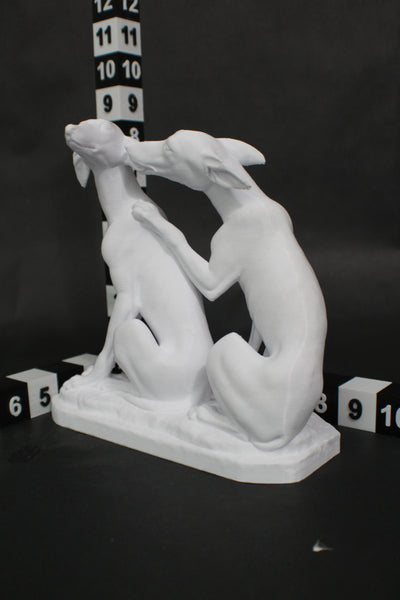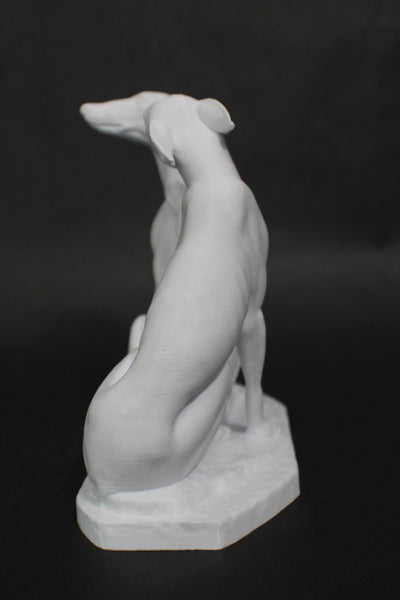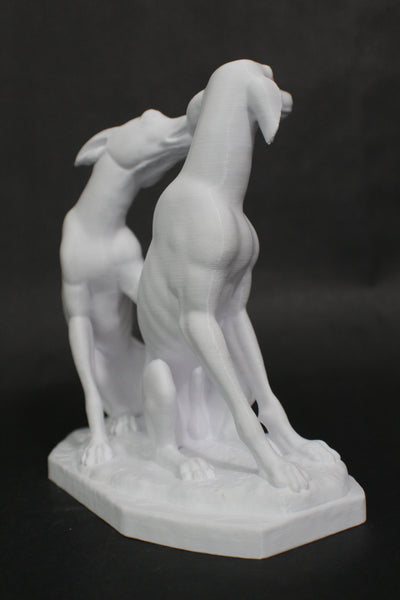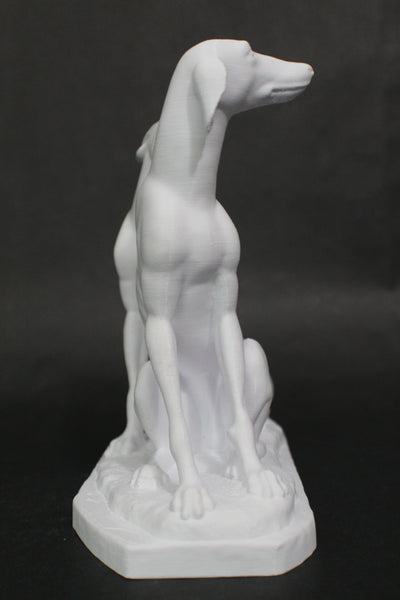The Townley Greyhounds Roman Statue Replica
This 3D printed replica of the roman statue The Townley Greyhounds.
Townley's description; ‘A group of a Dog and a B---- about two feet high, found 1774 at Monte Cagniolo, along with another group nearly similar to this, which is placed in the Vatican Museum’ (TY 12/3: Library 4). Although Townley usually described the animals simply as ‘dogs’, they were (wrongly) characterised as ‘greyhounds’, once by Townley himself (The First Townley Inventory): Statues 33), by Hamilton (TY 7/351) and later by Ellis, Newton, and Smith. They have more recently been identified as salukis by Sir Terence Clark.
Acquired from Hamilton in 1774. They seem to have been mentioned first in a fragmentary and undated note from Hamilton to Townley (TY 7/561): of the two pairs that had been found one would be required for the Pope but Townley would probably be able to have the other if he wanted it. This note is likely to have been written before the end of 1773 since by 7 January 1774 Hamilton made Townley a firm offer of ‘a group of two grayhounds’ for £50, along with other items that Townley declined (TY 7/563/2). On 15 February Hamilton acknowledged Townley’s acceptance: he was glad that Townley wanted the grayhounds ‘which I imagine you will look upon as one of your valuable pieces of sculptour tho at so low a price as fifty pounds’ (TY 7/565). Then on 21 March Hamilton had to break the news that Visconti had insisted first on seeing both pairs of hounds, and then on keeping for the Vatican the pair originally destined for Townley, to whom Jenkins would send the other pair (TY 7/566). The price of £50 was confirmed in a letter dated 5 August (TY 7/570). Townley actually offered £70, which Hamilton acknowledged with gratitude but declined to accept (TY 7/571, 16 September 1774). Nonetheless Townley recorded the purchase at this figure in TY 10/3 (fo. 31) and in ST 1 (fo. 21r), and even at £75 in TY 10/5 and TY 12/1. Hamilton’s figure of £50 appears in TY 10/6. Townley appears to have misremembered the detail.
DIMENSIONS AND WEIGHT
6" wide, 8" deep, and 8" high. Weighs 10 oz.
Note: Approximate measurements and weight
FEATURES
- Lightweight - Multiple busts can be displayed on floating shelves
- Accurate - Original statue scanned to create replica
- Collectible - Over 25 subjects in our ever-growing library
- 3D Printed - Intersection of technology and art to bring a unique presentation
PRODUCT CARE
Washable in lukewarm soapy water.
3D PRINTING
This is a 3D printed product, so there may be minor defects (rough edges, bumps, etc). I have spent months building my own machines to exact specifications for accuracy and surface quality, and I scrutinize every model very closely. I use only the highest quality filament to ensure colors are vibrant and defects are kept to an absolute minimum for both your item and my machine. Every item in my shop is test printed and checked for not only aesthetics, but also the intended use. If I'm not happy with it, it doesn’t ship. You will get my very best work, which you will find is a cut above the rest!
POLYLACTIC ACID (PLA PLASTIC)
Every item in my shop is made from Polylactic Acid (PLA), which is a non-toxic organic thermo-polymer made from corn starch or sugarcane and is industrially compostable under very specific and expensive conditions. It will not break down if buried or submerged in water and will last for a very, very long time. 3DPD makes every effort to repurpose and transform waste plastics such as support material and failed prints. One example of this is that our PLA waste is ground up into shards and suspended in the filled and premium bust product lines. Additionally, in-house colors such as black make use of a small percentage of waste plastics to recycle them. Anyone that makes the claim that PLA is “eco-friendly” or “biodegradable” is simply misinformed and has copy/pasted the erroneous marketing materials made available by the manufacturers. 3DPD will aspire to reduce, repurpose, recycle, or upcycle its waste streams and prevent as much material as possible from being sent to the landfill, and a portion of your purchase will be used to fund this ongoing research and development.






















